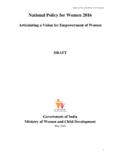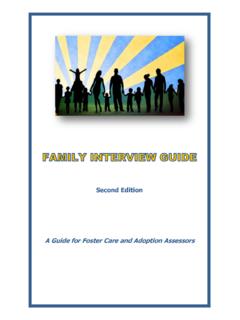Transcription of MODEL GUIDELINES FOR FOSTER CARE, 2015
1 MODEL GUIDELINES FOR FOSTER care , 2015 Ministry of Women and Child Development Page 1 India has a well developed and strong family system. In many areas the traditional joint family system is still very strong where a child grows in the company of his/her own siblings, cousin and grandparents. The term joint family is used more commonly than extended family in the country. In situations where parents are unable to take care of children due to illness or any other reason, children are taken care of by the joint family by the kins/relatives.
2 The present GUIDELINES are not aimed at institutionalising such informal family systems embedded in our socio cultural milieu and therefore do not cover such arrangements. In case, the extended family requires financial support in care of the child, the same may be provided through sponsorship of the child as provided for in Integrated Child protection Scheme(ICPS)itself or the family may be referred to other Schemes and Programmes of the Government that strengthen families.
3 The GUIDELINES for FOSTER care aim to protect the well-being of children who are deprived of family care or who are at risk of being so. The GUIDELINES derive strength from Section 42 of the Juvenile Justice ( care & Protection of Children) Act 2000, the Integrated Child Protection Scheme (ICPS) and the United Nations Convention on the Rights of the Child (1989). These GUIDELINES do not include pre adoptive FOSTER care as GUIDELINES Governing Adoption of Children, 2015 will apply.
4 MODEL GUIDELINES FOR FOSTER care , 2015 Ministry of Women and Child Development Page 2 Chapter I: Preliminary Short Title These GUIDELINES may be called the MODEL GUIDELINES FOR FOSTER care , 2015 . Definitions A. In these GUIDELINES , unless the context otherwise requires: (i). Abandoned Child means a child deserted by his biological or adoptive parents or guardians, who has been declared as abandoned by the Committee after due inquiry; (ii). "Act" means the Juvenile Justice ( care and Protection of Children) Act, 2000 (iii).
5 Adoption means the process through which the adopted child is permanently separated from his biological parents and becomes the lawful child of his adoptive parents with all the rights privileges and responsibilities that are attached to the biological child; (iv). Aftercare means provision of support, financial or otherwise, to persons, who have completed the age of eighteen years but have not completed the age of twenty-one years, to sustain themselves during the transition from institutional to independent life.
6 (v). Best Interest of child means the basis for any decision taken regarding the child, to ensure fulfillment of his basic rights and needs, identity, social well-being and physical, emotional and intellectual development ; (vi). Child care Institution means Children s Home, Open Shelter, Observation Home, Special Home, Specialised Adoption Agency and a Fit facility recognised under the Juvenile Justice ( care and Protection of Children) Act, 2000 for providing care and protection of children, who are in need of such services; (vii).
7 Child means a person who has not completed eighteen years of age; (viii). Committee means the Child Welfare Committee constituted under section 29 of the Act; (ix). Convention on the Rights of the Child means the United Nation s Convention on the Rights of the Child; MODEL GUIDELINES FOR FOSTER care , 2015 Ministry of Women and Child Development Page 3 (x). District Child Protection Unit means a Child Protection Unit for a District, established by the State Government under the Integrated Child Protection Scheme, which is the focal point to ensure implementation of the Act and other child protection measures in the district; (xi).
8 FOSTER care means placement of a child, by the Child Welfare Committee for the purpose of alternate care in the domestic environment of a family, other than the child s biological family, that has been selected, qualified, approved and supervised for providing such care ; (xii). FOSTER carers/parents means persons/parents that has been selected, qualified, approved and declared fit by the Child Welfare Committee for the placement of the child under FOSTER care ; (xiii).
9 Group FOSTER care means a family like care facility for children in need of care and protection who are without parental care with the aim to provide personalised care and fostering a sense of belonging and identity, through family like and community based solutions; (xiv). Guardian , in relation to a child, means his natural guardian or any other person, having, in the opinion of the Committee, the actual charge of the child, and recognised by the Committee as a guardian in the course of proceedings (xv).
10 Home Study Report means a report containing details of the family of FOSTER carer/parent, opting for individual or group FOSTER care which includes social and economic status; family background; description of home; standard of living; current relations amongst the members of family; health status etc. (xvi). Individual care Plan is a development plan for a child based on age specific and gender specific needs and the case history of the child, prepared if feasible in consultation with the child, in order to restore the child s self-esteem, dignity and self-worth and nurture him into a responsible citizen; (xvii).






